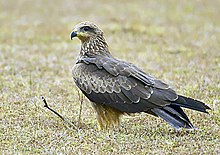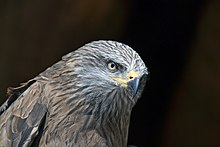চিলনী
| চিলনী (Black Kite) | |
|---|---|

| |
| বাংগালোৰত এটা চিলনী | |
| সংৰক্ষণ স্থিতি | |
| জীৱবৈজ্ঞানিক শ্ৰেণীবিভাজন | |
| জগৎ/ৰাজ্য: | Animalia |
| পৰ্ব: | Chordata |
| শ্ৰেণী: | Aves |
| বৰ্গ: | Falconiformes (or Accipitriformes, q.v.) |
| পৰিয়াল: | Accipitridae |
| গণ: | Milvus |
| প্ৰজাতি: | M. migrans |
| বৈজ্ঞানিক নাম | |
| Milvus migrans (Boddaert, 1783) | |
| উপপ্ৰজাতিসমূহ | |
|
5, see text | |

| |
| Black and Yellow-billed Kite ৰ গোলকীয় বিতৰণ কমলা: বাৰিষা কাল সেউজীয়া: সমগ্ৰ বছৰ জুৰি নীলা: শীত কালত | |
| সমাৰ্থক | |
| |
চিলনী (ইংৰাজী: Black Kite, বৈজ্ঞানিক নাম:Milvus migrans) এবিধ মধ্যমীয়া আকাৰৰ মাংসহাৰী চিকাৰী(bird of prey) চৰাই। অন্যান্য দিবাচৰ (diurnal) মাংসহাৰী চৰাইৰ পৰা ইয়াৰ পাৰ্থক্য এয়ে যে ই সুবিধাবাদী চিকাৰী (opportunistic hunter) আৰু কেতিয়াবা মৃত প্ৰাণীও আহাৰ হিচাপে গ্ৰহণ কৰে (scavenge)। খাদ্যৰ সন্ধানত ইহঁতে প্ৰায়ে আকাশত উৰি ফুৰে। চিলনীৰ কোণীয়া ডেউকা আৰু স্পষ্টকৈ বিভক্ত নেজ (forked tail) ৰ সহায়ত ইয়াক সহজেই চিনাক্ত কৰিব পৰা যায়।
বিৱৰণ[সম্পাদনা কৰক]
চিলনীৰ আকাৰ অন্যান্য মাংসহাৰী চৰাইতকৈ তুলনামূলক ভাৱে সৰু। ইয়াৰ নেজ কিছু অংশলৈকে বিভক্ত আৰু বৰণ সাধাৰণতে গাঢ় হয়। মতা আৰু মাইকী উভয়ে দেখাত একে। দেহৰ উপৰভাগ মুগা (brown) কিন্তু মূৰ আৰু ডিঙি কিছু শেঁতা বৰণৰ হয়। চকুৰ তলৰ অংশ কিছু গাঢ় হয়। ডেউকা ক'লা বৰণৰ আৰু পথালিকৈ ডাঠ আঁচ (cross bars) থকা দেখা যায়। দেহৰ তলৰ ভাগ শঁতা মুগা ৰঙৰ। চিলনীৰ ঠোঁট ক'লা, কাষটো হালধীয়া। ইয়াৰ ঠেং হালধীয়া। চিলনীৰ এটা স্পষ্ট আৰু তীক্ষ্ণ হুইচেলৰ দৰে মাত (shrill whistle followed by a rapid whinnying call) আছে। [2]
ক্ৰমবিৱৰ্তন আৰু টেক্সন’মি[সম্পাদনা কৰক]
বৰ্তমানলৈকে চিলনীৰ কেইবাটাও উপ-প্ৰজাতি চিনাক্ত কৰা হৈছে। এই উপ-প্ৰজাতি সমূহ হ'ল-
- Milvus migrans migrans (Boddaert, 1783): European Black Kite
- Milvus migrans lineatus (J. E. Gray, 1831): Black-eared Kite
- চাইবেৰিয়া ৰ পৰা আমোৰলেণ্ড (Amurland) আৰু হিমালয়ৰ পৰা উত্তৰ ভাৰত, উত্তৰ ইণ্ডোনেছিয়া আৰু দক্ষিণ চীন, জাপান লৈকে বিস্তৃত।
- Milvus migrans govinda (Sykes, 1832): Small Indian Kite (formerly Pariah Kite)
- Milvus migrans affinis (Gould, 1838): Fork-tailed Kite
- Sulawesi, পপুৱা নিউ গিনি ( Papua New Guinea) আৰু অষ্ট্ৰেলিয়াত পোৱা যায়।
- Milvus migrans formosanus (Kuroda, 1920): Taiwan Kite
- টাইৱান আৰু হাইনান (Hainan) ত বিস্তৃত হৈ আছে।
বিতৰণ[সম্পাদনা কৰক]


চিলনী ইউৰোপ, এছিয়া, আফ্ৰিকা আৰু অষ্ট্ৰেলিয়াত বহুলভাৱে বিস্তৃত। নাতিশীতোষ্ণ (temperate) অঞ্চলৰ চিলনী সমূহে প্ৰব্ৰজন কৰে বুলি জনা যায় কিন্তু ক্ৰান্তীয় (tropical) চিলনী সমূহ ঘাইকৈ থলুৱা। উদাহৰণস্বৰূপে [ইউৰোপ]]আৰু এছিয়াৰ উপ-প্ৰজাতি যেনে M. m. milvus আৰু M. m. lineatus আদিয়ে শীতকালত ক্ৰন্তীয় অঞ্চললৈ প্ৰব্ৰজন কৰে কিন্তু ভাৰতৰ M. m. govinda (Pariah Kite), বা অষ্ট্ৰেলিয়াৰ M. m. affinis (Fork-tailed Kite) আদি উপ-প্ৰজাতি সমূহ থলুৱা।[5]
ভাৰতবৰ্ষত M. m. govinda উপ-প্ৰজাতিৰ জনসংখ্যাই আটাইতকৈ বেছি আৰু ইহঁতক মানুহৰ ঘন আবাদীপূৰ্ণ অঞ্চলতে ঘাইকৈ দেখা যায়। ই বনাঞ্ছলত বসবাস নকৰে। ১৯৬৭ চনত নতুন দিল্লীত ১৫০ বৰ্গ কিল'মিটাৰ জোৰা এটা অঞ্চলত অধ্যয়ন কৰি মুঠ ২২০০যোৰ চিলনী পোৱা গৈছিল। [2][6]
আচৰণ[সম্পাদনা কৰক]
খাদ্য[সম্পাদনা কৰক]
চিলনীয়ে সাধাৰণতে আকাশত উৰি থাকি চিকাৰৰ সন্ধান কৰে। চিকাৰ দেখিলে চোঁ মাৰি নামি আহি জীৱন্ত অৱস্থাতে ধৰি নিয়ে। ই এবিধ সুযোগসন্ধানী চিকাৰী। মাছ, নিগনি, চৰাই আদি ইয়াৰ প্ৰধান খাদ্য। [7] ইহঁত সাধাৰণতে ধোঁৱা বা জুইৰ প্ৰতি আকৰ্ষিত হয় কাৰণ এনে অৱস্থাত পলাবলৈ ধৰা চিকাৰ ধৰিবলৈ সহজ। [8] এই আচৰণৰ বাবেই অষ্ট্ৰেলিয়াৰ অধিবাসীসকলে চিলনীয়ে জ্বলি থকা ডাল আদি শুকান ঘাঁহনিত পেলাই জুই লগাব পাৰে বুলি বিশ্বাস কৰে। [9] ভাৰতৰ চিলনী সমূহ নগৰ অঞ্চলত বসবাস কৰাত অভ্যস্ত। সেয়ে ইহঁতক ঘন আবাদীপূৰ্ণ ঠাইতো দেখিবলৈ পোৱা যায়। আনকি কোনো কোনো অঞ্চলত ই চোঁ মাৰি আহি মানুহৰ পৰা খাদ্যবস্তু কাঢ়ি নিয়াৰো বাতৰি পোৱা যায়। [2][10] চিলনীয়ে কেতিয়াবা অন্য চিলনীৰ বাহতো চিকাৰ কৰে।[11] তদুপৰি চিলনীয়ে কেতিয়াবা কণী বা পোৱালিৰ আশাত টোকোৰা চৰাইৰ বাহ চিঙি কঢ়িয়াই লৈ যোৱা দেখা যায়[12]
প্ৰজনন[সম্পাদনা কৰক]
ভাৰতত চিলনীৰ প্ৰজনন শীতকালত আৰম্ভ হয়। বাৰিষাৰ সময়লৈকে পোৱালিয়ে উৰিব পৰা হয়। চিলনীয়ে গছৰ ডালিৰে বাহ সাজে। [13] চিলনীয়ে বাহটো কেতিয়াবা উজ্জ্বল সামগ্ৰী যেনে বগা পলিথিনৰে সজোৱাৰ তথ্য পোৱা গৈছে। [14] মতা-মাইকী উভয়ে মিলি বাহ সাজে আৰু পোৱালিৰ যত্ন লয়। এবাৰত ২-৩টা কণী পাৰে।[10][15] পোৱালি জন্মৰ পৰা দুমাহ পৰ্যন্ত বাহত থাকে। [16] পোৱালিৰ মাজত দন্দ্ব হয় আৰু আটাইতকৈ দুৰ্বল পোৱালিটো প্ৰায়ে মৃত্যুমুখত পৰে। [17] জ্নমৰ দুবছৰৰ পিছৰ পৰা চিলনী প্ৰজননক্ষম হৈ উঠে।
আলোকচিত্ৰ[সম্পাদনা কৰক]
-
মাত মাতি থকা অৱস্থাত Milvus migrans govinda
-
Milvus migransৰ কণী
-
উৰন্ত অৱস্থাত হংকঙত Milvus migrans lineatus
-
অষ্ট্ৰেলিয়াত এটা চিলনী
তথ্যসূত্ৰ[সম্পাদনা কৰক]
- ↑ BirdLife International (2012). "Milvus migrans". IUCN Red List of Threatened Species. Version 2012.1. International Union for Conservation of Nature. http://www.iucnredlist.org/apps/redlist/details/160032423। আহৰণ কৰা হৈছে: 16 July 2012.
- ↑ 2.0 2.1 2.2 Whistler, Hugh (1949). Popular handbook of Indian birds (4 সম্পাদনা). Gurney and Jackson, London. পৃষ্ঠা. 371–373. ISBN 1-4067-4576-6. http://www.archive.org/stream/popularhandbooko033226mbp#page/n422/mode/1up/.
- ↑ Agoramoorthy, G (2005). "Disallow caste discrimination in biological and social contexts". Current Science খণ্ড 89 (5): 727. http://www.ias.ac.in/currsci/sep102005/727.pdf.
- ↑ Blanford WT (1896). Fauna of British India. Birds. Volume 3. Taylor and Francis, London. পৃষ্ঠা. 374–378. http://www.archive.org/stream/faunaofbritishin03oate#page/374/mode/1up/.
- ↑ Badley, John and Philip Hyde (2006). "The Black-eared Kite in Lincolnshire - a new British bird". Birding World খণ্ড 19 (11): 465–470.
- ↑ Galushin V M (1971). "A huge urban population of birds of prey in Delhi, India". Ibis খণ্ড 113: 552.
- ↑ Narayanan, E (1989). "Pariah Kite Milvus migrans capturing Whitebreasted Kingfisher Halcyon smyrnensis". J. Bombay Nat. Hist. Soc. খণ্ড 86 (3): 445.
- ↑ Hollands, David (1984). Eagles, hawks, and falcons of Australia. Nelson. ISBN 0-17-006411-5.
- ↑ Chisholm AH (1971). "The use by birds of tools and playthings". Vict. Nat. খণ্ড 88: 180–188.
- ↑ 10.0 10.1 Ali, S & S D Ripley (1978). Handbook of the birds of India and Pakistan. 1 (2 সম্পাদনা). Oxford University Press. পৃষ্ঠা. 226–230. ISBN 0-19-562063-1.
- ↑ Veiga, J. P. and Hiraldo, F. (1990). "Food habits and the survival and growth of nestlings in two sympatric kites (Milvus milvus and Milvus migrans)". Holarct. Ecol. খণ্ড 13: 62–71.
- ↑ Wesley,H Daniel; Relton,A; Moses,A Alagappa (1991). "A strange predatory habit of the Pariah Kite Milvus migrans". J. Bombay Nat. Hist. Soc. খণ্ড 88 (1): 110–111.
- ↑ Sergio, Fabrizio; Paolo Pedrini and Luigi Marchesi (2003). "Adaptive selection of foraging and nesting habitat by black kites (Milvus migrans) and its implications for conservation: a multi-scale approach". Biological Conservation খণ্ড 112 (3): 351–362. doi:10.1016/S0006-3207(02)00332-4.
- ↑ Sergio, F; J. Blas; G. Blanco; A. Tanferna; L. López; J. A. Lemus; F. Hiraldo (2011). "Raptor Nest Decorations Are a Reliable Threat Against Conspecifics". Science খণ্ড 331 (6015): 327–330. doi:10.1126/science.1199422. PMID 21252345.
- ↑ Kimiya Koga, Satoshi Siraishi and Teru Aki Uchida (1989). "Breeding Ecology of the Black-eared Kite Milvus migrans lineatus in the Nagasaki Peninsula, Kyushu". Jap. J. Ornithol খণ্ড 38 (2): 57–66. doi:10.3838/jjo.38.57.
- ↑ Desai,JH; Malhotra,AK (1979). "Breeding biology of the Pariah Kite Milvus migrans at Delhi Zoological Park". Ibis খণ্ড 121 (3): 320–325. doi:10.1111/j.1474-919X.1979.tb06849.x.
- ↑ Viñuela, Javier (1999). "Sibling aggression, hatching asynchrony, and nestling mortality in the black kite ( Milvus migrans )". Behavioral Ecology and Sociobiology খণ্ড 45 (1): 33–45. doi:10.1007/s002650050537.
লগতে চাওক[সম্পাদনা কৰক]
- Desai, J. H.; Malhotra, A. K. (1982). "Annual gonadal cycle of Black Kite Milvus migrans govinda". J. Yamashina Inst. Orn. খণ্ড 14: 143–150.
- Hardy, J. (1985). "Black Kite capturing small passerines". Australasian Raptor Association News খণ্ড 6: 14.
- American Ornithologists' Union (2000). "Forty-second supplement to the American Ornithologists' Union Check-list of North American Birds". Auk খণ্ড 117 (3): 847–858. doi:10.1642/0004-8038(2000)117[0847:FSSTTA]2.0.CO; 2.
- Crochet Pierre-André (2005). "Recent DNA studies of kites". Birding World খণ্ড 18 (12): 486–488.
- Forsman Dick (2003). "Identification of Black-eared Kite". Birding World খণ্ড 16 (4): 156–60.
বাহ্যিক সংযোগ[সম্পাদনা কৰক]
| ৱিকিমিডিয়া কমন্সত Milvus migrans সম্পৰ্কীয় মিডিয়া ফাইল আছে। |
| ৱিকিপ্ৰজাতিত Milvus migrans সম্পৰ্কে অধিক তথ্য আছে |




